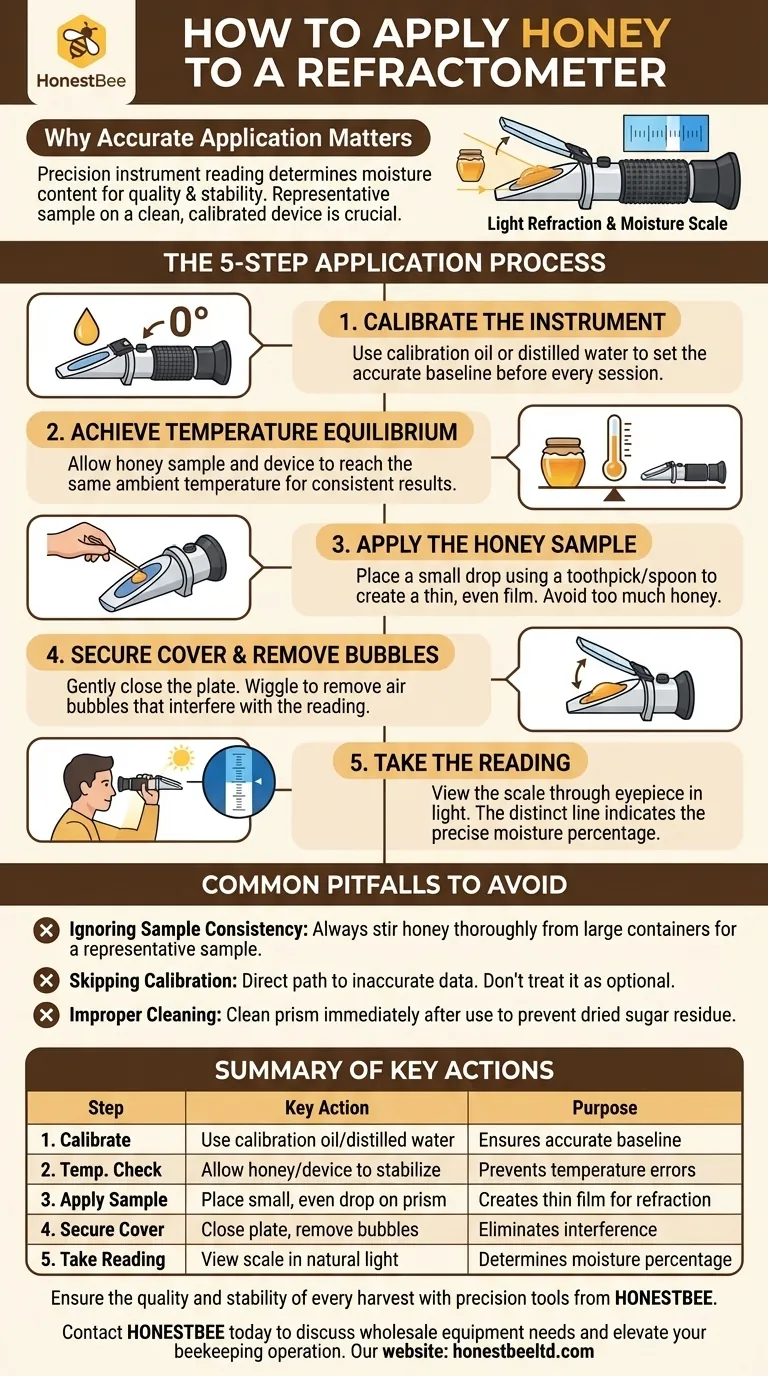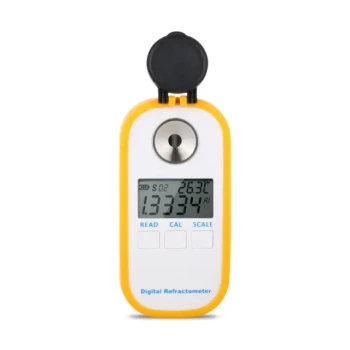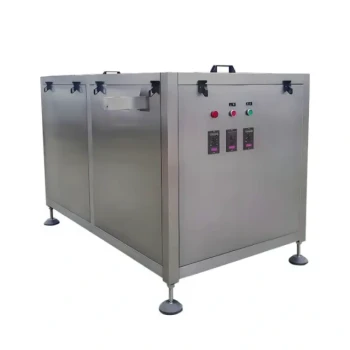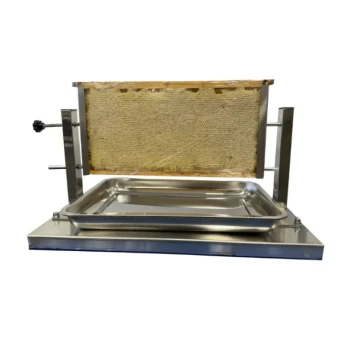To apply honey to a refractometer, you place a small amount directly onto the prism glass plate. Use a simple tool like a toothpick, a small spoon, or a hive tool to transfer just enough honey to completely cover the surface of the prism once the daylight plate is closed.
The goal is not just to apply the honey, but to apply a representative sample to a clean, calibrated instrument. This ensures the measurement accurately reflects the honey's true moisture content, which is critical for its quality and stability.

Why Accurate Application Matters
A honey refractometer is a precision instrument used to measure moisture content. This single reading determines if your honey is safe from fermentation and ready for harvest or sale. The way you apply the sample is the first step in ensuring that reading is reliable.
How the Measurement Works
A refractometer operates by measuring how much light bends, or refracts, as it passes through the honey. The concentration of sugar in the honey directly influences this bending. The device's internal scale is calibrated to correlate the angle of refraction with a precise moisture percentage.
The Critical Role of Sample Preparation
The honey you test must be representative of the entire batch. Inconsistent samples lead to misleading results, which can have significant consequences for your harvest.
If testing honey directly from the hive, it is generally ready without any special preparation. However, if you are testing honey that has been stored in a jar or bucket, it is crucial to stir it thoroughly first, as moisture levels can stratify, with different readings at the top versus the bottom.
The Step-by-Step Application Process
Follow these steps meticulously for an accurate measurement. The quality of your data depends entirely on the quality of your procedure.
Step 1: Calibrate the Instrument
Before any test, always calibrate your refractometer. This step ensures your baseline is accurate. Most models use a specific calibration oil or distilled water to set the zero point.
Step 2: Achieve Temperature Equilibrium
For the most accurate reading, both the honey sample and the refractometer should be at the same ambient temperature. A significant temperature difference between them can slightly alter the refraction and skew the result.
Step 3: Apply the Honey Sample
Using a clean toothpick or spoon, place a small drop of honey onto the main prism. You only need enough to create a thin, even film across the entire surface once you close the cover plate. Using too much honey can create a mess and make it difficult to get a clear reading.
Step 4: Secure the Cover and Remove Bubbles
Gently close the daylight plate (the clear cover) over the honey sample. You should see the honey spread evenly. If you see air bubbles, gently wiggle the plate back and forth to work them out, as they can interfere with the reading.
Step 5: Take the Reading
Hold the refractometer up to a natural light source and look through the eyepiece. You will see a scale with a distinct line separating a blue and white area. This line indicates the moisture content. Use the focal adjuster to bring the scale into sharp focus if needed.
Common Pitfalls to Avoid
Mistakes in preparation or cleaning are the most common sources of inaccurate readings. Being aware of them is the best way to prevent them.
Ignoring Sample Consistency
The most frequent error is testing unstirred honey from a large container. Taking a sample from the top layer may show a different moisture level than the honey at the bottom. Always homogenize your sample by stirring.
Skipping Calibration
A refractometer is a sensitive tool. Changes in temperature or jostling during storage can shift its calibration. Treating calibration as an optional step is a direct path to inaccurate data.
Improper Cleaning
After each use, the prism and daylight plate must be cleaned immediately with a soft, damp cloth. Allowing honey to dry on the glass will leave a sugar residue that will corrupt every subsequent measurement until it is thoroughly removed.
Making the Right Choice for Your Goal
Your testing context determines the most critical step.
- If your primary focus is spot-checking frames in the apiary: Apply honey directly from the comb, ensuring the sample is from sealed cells for the most accurate "ready for harvest" reading.
- If your primary focus is preparing a large batch for bottling: Thoroughly stir the entire container before taking your sample to guarantee the reading represents the final product.
- If your primary focus is maintaining equipment accuracy: Make it a rule to calibrate before every session and clean the instrument immediately after every single use.
Ultimately, mastering this simple process empowers you to make informed decisions that protect the quality of your honey.
Summary Table:
| Step | Key Action | Purpose |
|---|---|---|
| 1. Calibrate | Use calibration oil or distilled water | Ensures instrument baseline is accurate |
| 2. Temperature Check | Allow honey and device to reach ambient temperature | Prevents temperature-related reading errors |
| 3. Apply Sample | Place a small, even drop on the prism | Creates a thin film for light to refract through |
| 4. Secure Cover | Close daylight plate and remove air bubbles | Eliminates interference for a clear reading |
| 5. Take Reading | View scale through eyepiece in natural light | Determines the honey's precise moisture percentage |
Ensure the quality and stability of every harvest with precision tools from HONESTBEE.
As a trusted supplier for commercial apiaries and beekeeping equipment distributors, we provide the reliable refractometers and supplies you need to make confident, data-driven decisions. Protect your honey from fermentation and guarantee customer satisfaction.
Contact HONESTBEE today to discuss your wholesale equipment needs and elevate your beekeeping operation.
Visual Guide

Related Products
- Precision Honey Refractometer Instrument for Quality Assessment
- Digital Honey Refractometer for Precision Measurement of Optimal Honey Quality
- HONESTBEE 3-Frame Manual Acrylic Honey Extractor
- Professional Thermostatic Conical Honey Melter
- 8-Frame Electric Self-Reversing Honey Extractor Spinner for Commercial Honey Extraction Equipment
People Also Ask
- What are the key steps to using a honey refractometer? Ensure Honey Quality & Prevent Fermentation
- What is a honey refractometer? The Essential Tool for Perfect Honey Quality
- How does a honey refractometer work? Ensure Honey Quality & Harvest Readiness
- Why is a honey refractometer considered essential for commercial beekeepers? Ensure Honey Quality and Profitability
- What are the benefits of using a Pocket Digital Honey Refractometer? Achieve Precision & Speed in Honey Quality Control



















